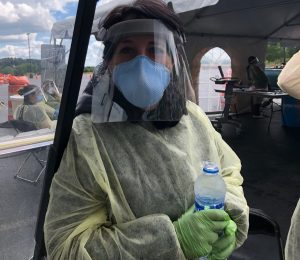
SALISBURY, MD—Communication is key in all aspects of life, but in the case of hospital staffs and COVID-19 patients, proper communication could be the difference between life and death.
Salisbury University faculty members and students are volunteering to work with Peninsula Regional Medical Center (PRMC) to break down the language barriers for Spanish- and Hatian Creole-speaking members of the community.
Corinne Pubill, chair of the Modern Language and Intercultural Studies Department, is coordinating the effort after PRMC reached out to SU for assistance.
Seven SU faculty members, including President emerita Dr. Janet Dudley-Eshbach, and more than a dozen students will assist in translations seven days per week for patients at SU’s Dogwood Village following COVID-19 treatment. An agreement between the University and PRMC has made the area available for temporary housing for patients who no longer need to stay at PRMC, but still need isolation. SU’s team members will work through virtual meeting software, and will not be on site.
As the SU team grows in numbers, it will also assist with patients on the PRMC campus.
The team began its work translating informational posters for Dogwood Village for the Spanish and Hatian Creole speakers who may need the facility.
In addition, Pubill worked as an interpreter this past weekend at the COVID-19 testing operation led by PRMC and the Wicomico County Health Department at Arthur W. Perdue Stadium in Salisbury for workers in Delmarva poultry plants and their families.
ESRGC Partners with PRMC for Ventilator Dashboard
As the pandemic developed, one of the most vital pieces of medical equipment which faced shortages was invasive ventilators.
The SU-affiliated Eastern Shore Regional GIS Cooperative has partnered with PRMC to create a dashboard with information on the number of ventilators in the Maryland/Washington D.C. area in reserve, the number of patients currently intubated and non-intubated COVID-19 patients.
Gaining a regional understanding of ventilator utilization will provide decision makers with information vital to resource distribution and redistribution as this pandemic continues. Data are submitted daily, on a volunteer-basis, by participating hospitals. Values are rendered anonymous through a process of systematic aggregation which displays information at the state and regional level.
The information can assist healthcare providers should they deal with an influx of patients in need of a ventilator, or for areas with a surplus of unused ventilators to offer assistance to other areas more in need.
The information is available at https://apps.esrgc.org/dashboards/covid/invasiveVentilators/
Are you or someone you know a member of the SU community who is helping in the battle against COVID-19? Send a message to Tim Brennan, assistant director of public relations, at tmbrennan@salisbury.edu with details so we can share their story.



